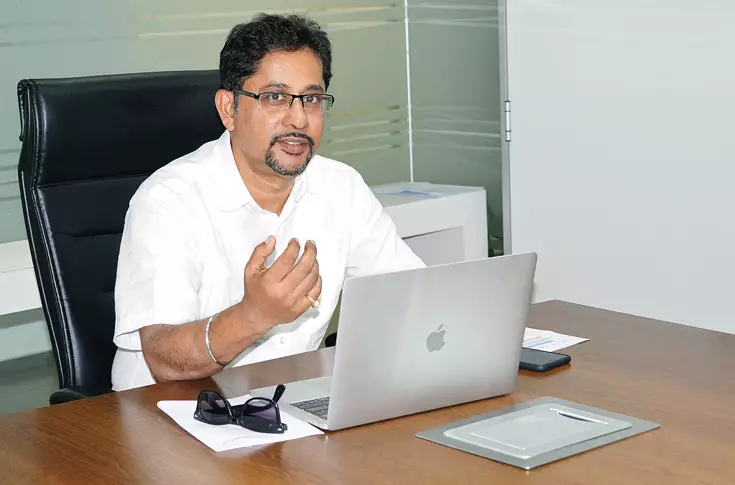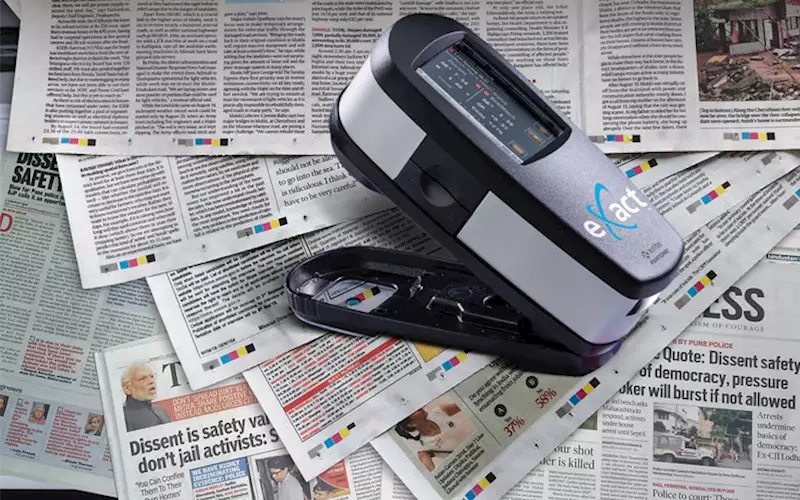What does it take to join the International Color Quality Club?
This year, 12 Indian publishers were inducted in Wan-Ifra’s International Color Quality Club. Rahul Kumar talks to four of them — The Hindu Group, Malayala Manorama, Times Group and Mathrubhumi
19 Sep 2018 | By Rahul Kumar
Started in 1994, International Color Quality Club (ICQC) is a print quality competition organised every two years, where the World Association of Newspapers and News Publishers (Wan-Ifra) offers newspapers worldwide an opportunity to demonstrate their colour printing excellence. The membership is offered to all companies which have successfully produced high-quality newspapers consistently over an extended time-period by following international printing standards. The competition is organised by the World Printers Forum (WPF), the print community within Wan-Ifra.
The quality evaluation is composed of two parts – an evaluation based on objective measurements made on a print test element (Wan-Ifra ‘Cuboid’) that participants must print every day of a specified week per month for a period of three months; and a visual inspection of the general print quality by a jury of international newspaper experts.
Participating companies must meet the defined quality criteria and should print without any common possible quality defects.
In its 23rd edition, this year, 121 publications from all over the world participated in the competition where for the first time, even magazine printers where allowed participation. Finally, total 67 publications, newspapers and magazines, produced by 54 publishing and printing companies in 20 countries achieved membership in the ICQC for two years.
There were 12 Indian publishers who were inducted to the club for the next two years — Anandabazar Patrika (ABP); Bennett, Coleman & Co; Express Publications (Madurai); Jagati Publications; Jagran Prakashan; Malayala Manorama; MM Publications; Sakal Papers; Telangana Publications; The Hindu Group Publishing; The Mathrubhumi Printing & Publishing and The Printers (Mysore).
Among them, Bengaluru-based The Printers (Mysore) has been inducted to the elite Star Club. This membership is presented to a printing company in recognition of outstanding printing quality if it achieves five or more stars by participating successfully in the ICQC or by obtaining Wan-Ifra certification for standardised printing.
The winning organisations will collect their certificates during the Wan-Ifra India annual conference to be held in Hyderabad from 25 to 27 September 2018.
But, what does a membership in International Color Quality Club actually mean? PrintWeek India asks.
What’s ICQC?
The quality evaluation is composed of two parts – an evaluation based on objective measurements made on a print test element (Wan-Ifra ‘Cuboid’) that participants must print every day of a specified week per month for a period of three months; and a visual inspection of the general print quality by a jury of international newspaper experts. Participating companies must meet the defined quality criteria and should print without any common possible quality defects.
Getting ready for ICQC
In a production function, with the adoption of quality assurance procedures, the products are evaluated through internal quality systems. “When you take part in ICQC, the evaluations are carried out by Wan-Ifra, and you get to compete with newspaper and magazine producers across the world. This gives the recognition to the people and the organisation,” says PVS Giridhar Rao, DGM, Hyderabad plant of The Hindu Group of Publications.
“As far as the preparations are concerned, we formed a core team in each participating print centres led by the plant-in-charges,” Rao explains. “They made these teams understand the instructions and allocated responsibilities. The central team in corporate gave the required support on providing the right raw materials, coordinating with pre-press and editorial staff for cuboid placements.”
According to Susheel George of Malayala Manorama, the company decided to participate in ICQC to know where they stand within the international benchmark. “Also, such tests help us train the team in calibrating the process,” says George, adding, “We have a practice of test printing once in six months. We use the ICQC target as a tool to calibrate our systems.”
On the other hand, Snehasis Roy of Times Group says ICQC is the only platform that allows membership based on quality parameters maintained as per international standards (ISO 12647-3). “This is the most convenient way to calibrate and upgrade product standards at all the production facilities,” he says.
As for best practices at Times Group, Roy adds, “We institutionalised the ISO product standard as the only standard to be maintained at all print facilities. So, there was no special preparation. We had an internal workshop to reinforce the requirements of the standard.”
For PT Bhasi, general manager, production and maintenance, The Mathrubhumi Printing & Publishing, the quest for enhanced print quality has been a major driving force for the organisation and this is the reason why the company participated in ICQC in the last three cycles. “Though the evaluation is for the first three consecutive months from January, we prepared for it six months earlier. We conducted training sessions for all pre-press and press staff and conducted a series of test runs,” he explains.
Membership benefits
“Apart from the recognition of your quality systems and products, this competition helps align production functions and editorial functions vigorously,” says Rao. “Also, it encourages the shopfloor staff to stay motivated on quality parameters.”
For George, the key benefit is the chance to benchmark the company’s quality level. “The exercise also helps us train our team. This time, five of our printing units participated in category 1 and all five units won the ICQC award,” he says.
Roy breaks down the benefits. One, calibration of print outputs from different press infrastructures across the country. Two, benchmarking of capabilities with the best in the world in print publishing. Three, process capabilities improvement. And four, customer confidence.

Roy: ISO 12647-3 is the standard on which our quality systems are calibrated. The same standards are used for ICQC evaluation
According to Bhasi, the steps involved in the exercise enhanced the level of understanding across the whole organisation. From the selection of pictures, positioning them and reproducing in the press, everyone was aware of the importance of their roles. “This has greatly enhanced the quality of all our products. The customers are also aware of the efforts, costs and the ultimate benefit,” he adds.
Managing quality across board
Making a print production plant up-to-date with quality standards is perhaps not hard, but to implement the same stands at different plants located at different parts of the country must be hard. After all, India is a big geography with different atmosphere and weather conditions. How did the publishers tackle issues like transportation of material, moisture and dust, and others?
“For the competition, we selected the right quality of required material from the available resources. We also took care of storage (as in some places, there is a big delta in seasonal variations during pre-check and actual testing periods),” says Rao.
Like Rao, George too agrees that the organisation did not face any serious issues regarding transportation of consumables.
Says Roy, “All our infrastructure has moisture and dust-controlled environment. Our transportation and logistics are best in the country.”
On the other hand, according to Bhasi, more than transport conditions, the warehousing and pressroom conditions have a bigger role in the performance of the materials. “Standard pressroom and storage conditions helped us a lot in this direction. Another factor of major bearing is the local weather. Past experience and operator training has given us an edge in overcoming these difficulties,” he adds.
Printing quality
Now, to the key point, how did the publishers maintain continuity in dot gain, LAB value, gray balance and registration especially back-to-back?
Bhasi explains: “Test runs, measurements, calibration, all these have to be done at regular intervals. Raw materials have to be consistent. Maintenance has to be systematically thorough. Rollers’ condition and pressures have to be precise, and blanket properties have to be up to the mark.”

Bhasi: Test runs, measurements, calibration, all these have to be done at regular intervals. Raw materials have to be consistent
While Wan-Ifra evaluation is done on copies printed in January, February and March of the year, Bhasi says the company was preparing for the competition since June of the previous year. “In addition to training, we printed a series of tests involving all the major raw materials. By the time the evaluation prints started, we knew which combinations at what conditions were giving better results,” he adds.
According to Roy, these are the basics of print production compliance. “Our state-of-the-art infrastructure is designed to perform these tasks with ease. Our consumables and materials are standardised based on these requirements,” he says.
On the other hand, Malayala Manorama has a system in place to check the calibration, including the press. Dot gain, LAB, gray balance are monitored and maintained as per the schedules. “We also have IMS (Integrated Management System - ISO 9001-2018, OHSAS 18001 and ISO 14000) in place. So we do strictly follow the system procedures and maintain it meticulously,” George says.
Rao also explains that at The Hindu, the company did not have to do much regarding dot gain and registration as it was already consistent. “For consistency in LAB values, we have taken extreme care in selecting the raw materials and had discussions with the vendor for maintaining consistency,” he adds.
Print consistency
According to the ICQC rules, a newspaper/ magazine publication house has to produce and submit six printed samples in three months, on an average, a sample after each 15 days. Thus, consistency in production is the key. What were the challenges in following this rule?
Roy agrees that consistency is the key for print quality. “We do Pp and Ppk studies regularly and maintain an acceptable machine capability index for all press lines,” he adds.
George says there were no big challenges as the newspaper was doing this frequently to calibrate the press and process. “This helped us print the ICQC target without much effort,” he says.
For Rao, the biggest challenge was the positioning of quality check cuboid in the page, that too with the low image area. “We overcome this by creating awareness with our pre-press and editorial teams,” he adds.
Need for pre-check
To maintain this consistent quality, was free test run, the so-called ‘Pre-check’ useful?
Rao says pre-check has helped the organisation to know the measuring meter differences between each participating centre and Wan-Ifra. “This helped in fine-tuning the quality parameters like density, dot gain and gray balance,” he says.
George too agrees that pre-check was helpful. “We were using this online facility to generate reports. We also generated our own pre-check formulas to calculate various parameters mentioned in the 12647-3/ ICQC standards,” he adds.
Following standards
Do the publishers follow International Color Consortium (ICC) and ISO 12647-3 standards for newspaper production?
Roy says, “ISO 12647-3 is the standard on which our quality systems are calibrated. The same standards are used for ICQC evaluation. So, it’s 100% help.”
George says Malayala Manorama has been following ISO 12647-3 standards from 2000. It was fully implemented by 2004 after ICONS project by IFRA India.

George: The exercise also helps us train our team. This time, five of our printing units participated in category 1 and all five units won the ICQC award
The company started the standardisation programme in 1992 by following in-house standards. At the time, it faced lots of complaints from advertising agencies on colour and colour matching issues with the progressive proofs.
“This made us consider a move from in-house to international standards. Our director George Jacob and other management members also supported us on this. Our quality journey started from there. All our purchases were then onwards based on the international standards. This finally led us to consistency in reproduction,” George says.
Consumables partners
What kind of help did the publishers get from their chemical/ consumable partners to achieve the score?
Again, Rao reiterates, like consistency in quality, consistency of material is also the key. “We use inks from different manufacturers in participating print locations and we have had no issues in that. Other consumables qualities were consistent too,” he adds.
According to George, the most important variable in offset printing is the ink. “Since 2000, we are using ink from Nanotech Printing Inks, based in Kottayam, Kerala, based on the specifications of 12647-3 standard. Similarly, we purchase consumables from different reputed companies in India and abroad, also based on the specification of 12647-3 standards,” he says.
Roy says, “Our vendors work hand-in-hand with us providing consistency and conformance in supply. Here, I would like to give a special mention to our suppliers for their support in this journey — TechNova for Green Violet plates, Fogra fountain solution and washes, our inks and other consumable suppliers.”
Bhasi adds that the company uses top quality raw materials. “TechNova, DIC, Kenyoetc are a few to name. Still, you have to be in constant interaction with suppliers for success in such efforts. Effective partnership with vendors helped us convert the grey problem areas into colourful workspace in the exercise,” he says.
Magazines in the mix
This year, for the first time, magazine publishers were also eligible to compete for ICQC. Unlike the daily printing of newspapers, magazine printing needs a different parameter. Does this dilute the original vision of the competition in any way?
Susheel George of Malayala Manorama is positive about the development. “The Malayala Manorama Group also publishes several magazines. We feel the inclusion of magazines has helped boost the morale of our heatset printing team. This time, they also got a platform to showcase their capabilities to produce the best output consistently. In this category, The Week magazine from the Malayala Manorama group won the ICQC award.”
Roy agrees, “Print quality parameters are optically measurable against standards and newspaper and magazines have separate standards for evaluation. I don’t see any problem here,” he says.
Do we need such a competition?
Last, but not the least important question, do we need such a stringent quality competition for a newspaper? After all, a newspaper’s life is too short, just a few hours.
Rao says yes, definitely. “We call it standardisation or benchmarking to improve customer satisfaction levels,” he adds.

Rao: We formed a core team in each print centre led by the plant-in-charge. They made the teams aware
George feels the same. “The standards have helped us to attain consistency in reproduction and also control consumption of consumables and cost of production,” he says.
Roy has the last word. “It’s true that newspaper has a very short shelf life, but look at the kind of excellence they have to provide today to ensure advertisement reproduction. In terms of resolution, contrast, colour conformity and details, we are competing with HD media all across. How can quality be comprised if we need to survive in such an environment?”











 See All
See All